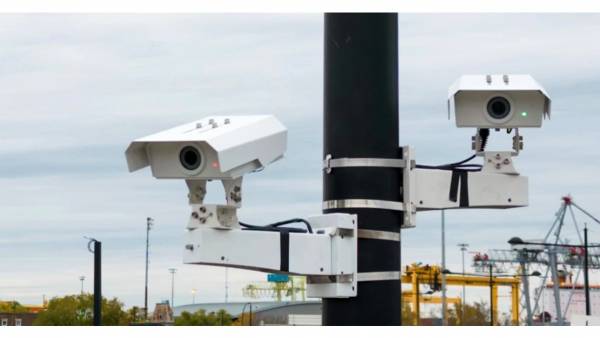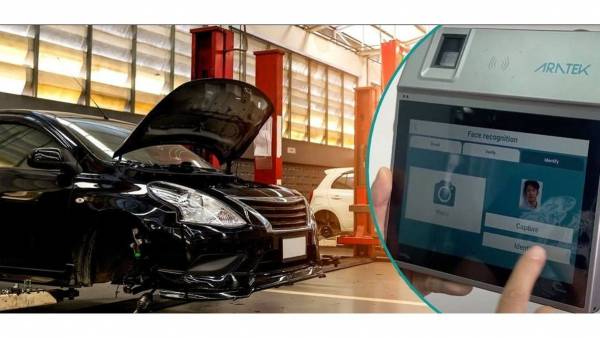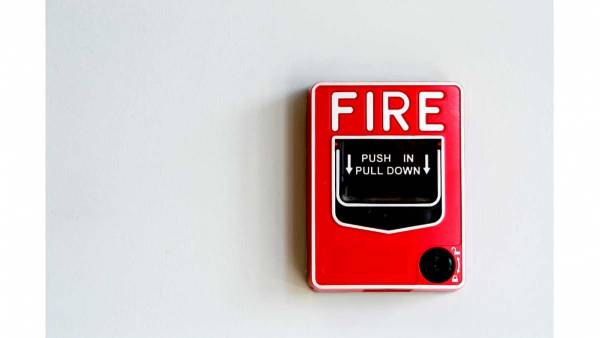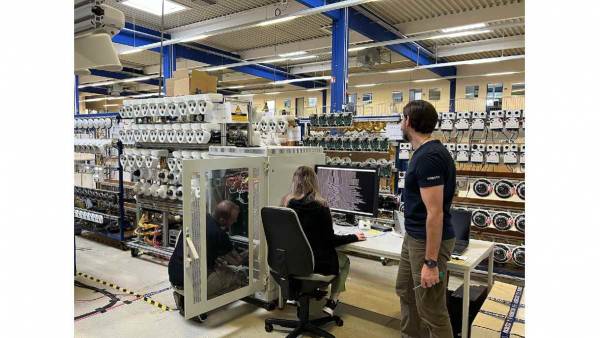By: Alejandro Vega, General Manager of Mexico- Samsung GVI Mexico and Alexander Gutiérrez, Ventas Area Andina -Samsung GVI Colombia.
 Currently, advanced camera techniques capture sharp, detailed images. Digital recorders retrieve sequences instantly. New video surveillance technologies make it possible for managers to reduce their reliance on expensive security guards, decrease false alarms, and greatly increase the important details captured by their cameras.
Currently, advanced camera techniques capture sharp, detailed images. Digital recorders retrieve sequences instantly. New video surveillance technologies make it possible for managers to reduce their reliance on expensive security guards, decrease false alarms, and greatly increase the important details captured by their cameras.
Digital video surveillance systems allow mall staff to watch live or pre-recorded video on any camera on the warehouse network and from anywhere they have Internet access.
Although it is an important reason to have a video system, theft is not the only problem of shopping centers. The video eliminates fraudulent "slip and fall" payments, which turns out to be one of the top liability concerns of retail warehouses. It also lets shoppers know they're protected, which is why many mall operators prioritize parking when developing their video systems. Video users can also use the cameras to check for traffic jams or other issues in or around the mall.
An overview
Generally, dome chambers are strategically located to cover all common areas. In most cases, the dome system automatically switches color modes for daytime use to a monochrome display for the night. This makes it possible for a camera to offer 24-hour surveillance, reducing equipment and maintenance costs. Fixed cameras are generally used in different service areas, including charging ports, restrooms, and emergency exits.
In addition to providing greater security, mall managers generally want to use the system to monitor essential areas and make sure some mall operations run smoothly.
Cameras monitor cleaning staff and general staff to maintain the integrity of the mall. Fixed cameras located on the stairs minimize liability issues. A camera located in front of the mall's monitors eliminates the use of valet service and ensures that streets remain clear.
The cameras also record vehicles coming in and out, and at the same time monitor parking floors to see how full they are. If a vehicle needs to be towed, records show if the car has been there between five minutes and an hour. In the event of an accident, staff can also zoom in on vehicle license plates.
With a digital IP surveillance system or a professional DVR, the mall manager can view any camera or roll back an image at any time, as well as send the image you want to others over the Internet.
The challenge of lighting
Real-world lighting has long been the "Achilles Heel" of camera installers and users around the world, but it's particularly a problem for large retail malls that have a variety of internal and external lighting conditions.
Conventional cameras generally force malls to install cameras where the light sets it, not where they are needed. However, digital camera technology changes the landscape of CCTV with sharper images than ever before.
With traditional cameras, external details can be distorted by bright light. Security personnel cannot see the trucks inside and the cargo ports. Highly lit external doors prevent you from clearly seeing what is happening inside the warehouse entrance. Spotlights avoid seeing plaques on parking floors. Poor lighting does not allow you to see important details in the video.
However, the new technology exposes each pixel in a digital image separately, offering a clear image in places where it was initially impossible. These new cameras show a perfect image quality equal to what people see with the naked eye.
For example, adaptive motion DNR takes the typical dark gray images and lightens them. Digital image stabilization eliminates blurry images produced by motion, and presents a still, clear image. The cameras also incorporate a reduction of low light noise and have a color suppression function. In addition, the XDR (Extended Dynamic Range) feature fixes darkness and brightness issues that make images unseen clearly. The WDR (Wide Dynamic Range) feature delivers clear images even under black light circumstances, avoiding glare issues.
Such technology increases exposure in shaded areas and decreases exposure in illuminated areas, offering a light-corrected image that clearly shows important details. It even adapts to different lighting conditions within the same image.
Although ordinary surveillance cameras are affected by glare, reflections, backlighting, and shadows that prevent clearly seeing important details, new camera technologies allow users to see everything. When installed in a mall corridor, they can see clear images of people's faces as they enter the mall, even if the camera directly has bright reflections or sunlight. In addition, the management of the shopping center can visualize the vehicles and objects on the parking floor. These cameras with wide dynamic range are especially ideal for capturing facial features at the entrances of shopping malls.
Tip 1: Why do most malls prefer Megapixel Cameras at entrances and in parking lots?
If the main objective of a camera is to capture a face at the entrance or a plaque in the parking lot, a very clear image must be produced. Without this, no facial or plate recognition software can be effective. That's why most malls are opting for megapixel cameras instead of analog PTZ, or even standard digital IP PTZ cameras, for these types of places.
The image quality advantages of megapixel network cameras benefit shopping malls in several ways. In some applications, a megapixel network camera can cover the same area as the other cameras, but with an improved level of image quality. For example, almost everyone knows the images captured by CCTV systems, in which the quality is so poor that little can be determined from the recording and, very often, a positive identification is not possible. Megapixel network cameras solve this great disadvantage by producing greater resolution and clarity.
In other applications, megapixel cameras cover a much wider area than standard CCTV cameras. For example, a one-megapixel network camera can cover more than four times the area of a CCTV camera, with the same resolution. This means that a mall can opt for a megapixel camera with four times (4x) the resolution of a standard camera or even a 3.1 MP camera with ten times (10x) the resolution of a standard camera.
That's why malls have embraced the power and efficiency of megapixel cameras, when lighting conditions allow.
Tip 2: Buyers want to know they are safe.
Mall workers and shoppers feel more comfortable and safer when they know there is a surveillance system watching them. Many comment that they no longer shop in places that do not have surveillance cameras.
To alert them, many malls show live video on a large screen, such as Samsung's large-format screen, to announce that surveillance cameras are being used. People literally see themselves on the monitor. Such a video wall is very easy to install and can be used for multiple purposes.
For example, Samsung's SMT-4011 large format monitor offers an MDC (Multiple Display Control) feature that allows mall management to control up to ten units from a single computer with MDC software. The Built-in Video Wall Image Enlargement Processor supports 2 x 2, 3 x 3, 4 x 4, 5 x 1, and 1 x 5 video walls, with no separate video controller devices required.
Additional distribution of input signals is not required to use the video and PC interface. When surveillance video is not displayed, these monitors can additionally display a variety of advertising and multimedia messages. These professional monitors differ from standard TVs in that their screen protection techniques can display the information without worrying about the screens burning.
Tip 3: Improving the advantages of remote monitoring – involving local police?
Instead of using dedicated point-to-point cabling as is done in standard practice in analog video surveillance systems, a network video system employs standard LAN/WAN/Internet technology as the backbone for transporting images and information. Since most facilities, including shopping malls, already use these networks for data transmission, communications, and advanced applications, the network video system technology used simply expands this same infrastructure, improving its use for remote video surveillance.
By connecting to the Internet, a mall can share its video with local law enforcement, so they can have access to certain cameras, take panoramic shots and zooms in from the office, and respond quickly when needed. In other cases, the mall itself does all the surveillance but, when an accident occurs, the video can be immediately sent to the police station so they can respond quickly, knowing exactly where they should go and what they are facing.
In some cases, the mall may implement a video system in partnership with local government authorities. In this regard, many of the cameras are also used for other public safety matters, located on neighborhood streets to visualize traffic and get an idea of vehicle congestion and other safety issues.
This is especially true if the mall is located in the middle of an area the city would like to keep an eye on. In these cases, the government buys and installs its own cameras and uses the property and cameras as a command center.
Selecting the appropriate system
Determining exactly what you want your surveillance system to do will help you specify the type of surveillance system to use. The three tips mentioned above will help you decide what types of technology and/or components should be implemented.
























Leave your comment